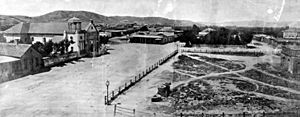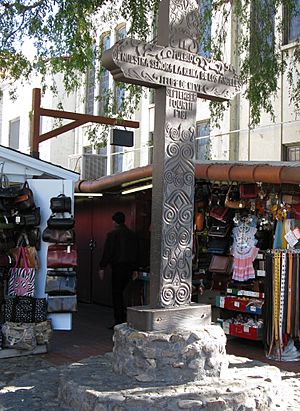Pueblo de Los Ángeles facts for kids
El Pueblo de Nuestra Señora la Reina de los Ángeles del Río de Porciúncula is a very long Spanish name. It means "The town of Our Lady the Queen of the Angels of the River of the little portion." Most people just called it Pueblo de los Ángeles. This was the Spanish town founded in 1781 that later grew into the huge American city of Los Angeles.
The town was built with the help of local Native American workers from the nearby village of Yaanga. The Spanish settlements in California were of three types:
- Presidio: A military fort.
- Mission: A religious center run by priests.
- Pueblo: A civilian town.
The Pueblo de los Ángeles was the second civilian town created by the Spanish in California. The first was San Jose, founded in 1777. The Pueblo de los Ángeles was started twelve years after the first fort and mission, which were the Presidio of San Diego and the Mission San Diego de Alcalá (both in 1769).
The first group of settlers included 44 people in eleven families. They came mostly from a region in Mexico called Estado de Occidente. As more settlers arrived and soldiers retired, Los Angeles became the main city in southern California. Life there focused on raising livestock (like cattle) on large farms called ranchos.
Contents
How Los Angeles Was Founded
In 1542, Juan Rodríguez Cabrillo was the first European to sail along the California coast. He claimed the land for Spain, but Spain didn't try to settle there for over 200 years. Later, Spain became worried that Russia and France might try to claim the land. So, in the 1760s, Spain decided to establish its presence in California.
Spanish settlers finally reached California in 1769. Explorer Gaspar de Portolà arrived in the San Diego area by land from Mexico. Two Franciscan priests, Junípero Serra and Juan Crespí, came with him and wrote about the journey. As they passed through what is now Elysian Park, Los Angeles, they were amazed by a river. Father Crespí named it El Río de Nuestra Señora la Reina de los Ángeles de Porciúncula. This long name means "the River of Our Lady Queen of the Angels of Porciuncula." The name comes from a small town in Italy called Santa Maria degli Angeli, which has a church called Porciuncula. This is where St. Francis of Assisi, who started the Franciscan order, lived his religious life. The river Father Crespí named is known today as the Los Angeles River.
Father Crespí thought a spot along the river would be good for a settlement. However, in 1771, Father Serra instead sent missionaries to build the Mission San Gabriel Arcángel. This mission was near the San Gabriel River. The missionaries faced challenges from the Tongva who didn't want to move to the mission. In 1776, a flood damaged the mission, so it was moved to a higher, safer location in San Gabriel, California.
The first Spanish governor of California, Felipe de Neve, also suggested Father Crespí's location on the Los Angeles River for a mission. But in 1781, King Charles III decided that a pueblo (town) should be built there instead. This would be the second town in California, after San José de Guadalupe in 1777. The King wanted more civilian towns to grow food and trade goods. He thought these towns were more important for supplying the Spanish military than the missions were. However, the priests at the missions often ignored this rule and continued their own farming and trading.
The First Settlers
Governor de Neve took his job seriously. By May 1780, he had detailed maps and plans for the new town. These plans showed where government buildings, homes, the church, farms, and river access would be. But finding the pobladores (settlers) was harder. After not finding enough families in one area of Mexico, he had to go further south. He finally found 11 families, which included 11 men, 11 women, and 22 children. These settlers came from different backgrounds, including Criollo, Mulatto, and Negro people.
According to local stories, on September 4, 1781, the 44 settlers gathered at San Gabriel Mission. They were escorted by soldiers and two priests to the spot Father Crespí had chosen. In reality, some families might have already been working on their land plots as early as July. Governor de Neve named the new town El Pueblo de la Reina de los Ángeles (The Town of the Queen of the Angels).
Following Spanish laws, new towns in California were supposed to have land that stretched one league (about 3 miles) in every direction from the town center. The streets were laid out at a 45-degree angle from the main compass directions. This street plan can still be seen in Downtown Los Angeles today. The old town boundaries are marked by Hoover and Indiana Streets. In 1784, a small church, called an asistencia or sub-mission, was built on the central plaza to serve the settlers.
The Plaza Church
On August 18, 1814, a priest named Luis Gíl y Taboada laid the first stone for a new Franciscan church. It was built on the ruins of the first small church. The new building was finished and dedicated on December 8, 1822. In 1861, a replacement chapel was built using materials from the original church. It was named La Iglesia de Nuestra Señora de los Ángeles (The Church of Our Lady of the Angels). The word Reina (queen) was added later to match the town's name.
This small chapel, also called "La Placita" or "the Plaza Church," was the only Catholic church in Los Angeles for many years. It served both the local Californio people and immigrants. In 1876, the Cathedral of Saint Vibiana was built. Saint Vibiana Cathedral became the church for English-speaking people, and La Placita became the church for Spanish-speaking people. "The Plaza Church" still stands today. It shows off Spanish Colonial and Carpenter Gothic building styles.
Mexican Independence and Changes
After Mexico won its War of Independence from Spain (1810–1821), life in Los Angeles and California began to change. The missions were secularized, meaning their lands were taken from the church. These lands were then given out to create many more large farms called ranchos. The Native American people were often moved or became part of the Hispanic population.
Around 1827, Los Angeles became the largest town in the territory. It started to compete with Monterey to be the capital of California. Los Angeles was also a center for groups who wanted to overthrow Mexican authority. It was a stronghold for the southern California side in the disagreements that lasted until the Americans took over.
In 1835, Richard Henry Dana Jr. visited San Pedro Harbor as a sailor. His book, Two Years Before the Mast, describes the town and area. At that time, the town depended on exporting cattle hides and tallow (animal fat). In 1835, the Mexican Congress made Los Angeles a city and declared it the capital. However, this rule was not fully put into practice and was soon changed. From 1845 to 1847, Los Angeles was the actual capital of California.
In 1842, a sheep rancher found gold in Placerita Canyon, just north of the city. This discovery started a small gold rush. In the years that followed, people used different mining methods to find gold. However, land turned out to be even more valuable than gold. Ranching and development grew as the town and region expanded.
The Mexican–American War
The idea of Manifest Destiny, which was the belief that the United States was meant to expand across North America, reached California during the Mexican–American War (1846–1848). On June 18, 1846, a small group of Americans raised the California Bear Flag and declared independence from Mexico in northern California. United States troops then took control of the forts at Monterey and San Francisco.
In southern California, Mexican citizens fought back against American troops for five months. About 160 vaqueros (cowboys) on horseback, armed only with lances, fought against about 700 American soldiers.
Los Angeles first surrendered to the American forces. The small Mexican forces in Los Angeles ran away when US troops arrived. On August 13, 1846, the American flag was raised over the city. A group of fifty US Marines was left in charge. The people of Los Angeles had been arguing among themselves before the war. But the American occupation made both sides unite against the invaders.
The Marines were forced to leave in October when the residents, especially the Californio Lancers, revolted. They chased the US forces back to San Pedro Harbor. Los Angeles was not taken back until January 10, 1847, after several battles. These battles showed the strong resistance of the Californios, even though they were greatly outnumbered and outgunned.
In January 1847, Lieutenant-Colonel John C. Frémont and Governor of Alta California Andrés Pico signed the Treaty of Cahuenga. This was an informal agreement to stop fighting in California. Later, in 1848, the Treaty of Guadalupe Hidalgo was signed. Under this treaty, Mexico officially gave nearly half of its land, including California, to the United States.
Modern Historic Park
In the 1920s, a woman named Christine Sterling led an effort to restore the historic area, starting with Olvera Street. Today, the original area of the Pueblo is preserved as the El Pueblo de Los Angeles Historic Monument.
Among the saved and restored buildings is the oldest house still standing in Los Angeles City. This is the 1818 Avila Adobe, built by Francisco Avila. He owned a large ranch and a successful cattle business. Across Olvera Street is the 1887 Eloisa Martinez de Sepulveda House. This building now serves as the Visitors Center for the historic district. In 1939, the important Union Station was built east of the old Plaza. This large train station helped bring new life to the Pueblo area.
Archaeologists have also found parts of the original brick-lined Zanja Madre (the Mother Ditch). This was a system of canals and aqueducts that brought water from the Los Angeles River to the early town. It continued to supply water to the American city into the late 1800s.
See also
In Spanish: Pueblo de Los Ángeles para niños





